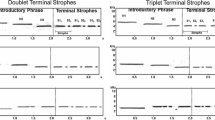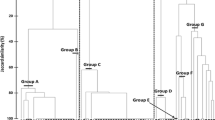Abstract
Divergence in song culture has been well documented among isolated bird populations. Montane populations separated by unsuitable lower-elevation habitats thus appear to be excellent candidates for cultural divergence, and existing data support this conjecture. To explore the generality of this phenomenon, we investigated song sharing patterns in songbird species breeding in isolated alpine life zones in the Rocky Mountains of Colorado. We recorded songs of American Pipits (Anthus rubescens alticola), Wilson’s Warblers (Cardellina pusilla pileolata), and White-crowned Sparrows (Zonotrichia leucophrys leucophrys) across 19 sites among 6 mountain ranges. We used spectrographic cross-correlation to calculate song similarity coefficients between individuals within and among populations. White-crowned Sparrows exhibited significantly elevated song sharing within isolated mountain ranges, but Wilson’s Warbler and the American Pipit did not. Cluster analyses showed that White-crowned Sparrow songs diverged among alpine fragments but were generally similar among sites within contiguous alpine habitat within mountain ranges. There was no such clustering within American Pipit or Wilson’s Warbler populations. Song similarity declined with distance between sites within contiguous alpine habitat in White-crowned Sparrows but not in American Pipits or Wilson’s Warblers. Our results provide convincing evidence for the existence of geographically structured vocal culture in White-crowned Sparrow populations in Colorado, and this geographic pattern may be explained by clinal variation rather than by a mosaic pattern of divergence among isolated alpine fragments.
Zusammenfassung
Kulturelle Unterschiede in den Lautäußerungen dreier Singvogelarten in isolierten alpinen Habitaten sind nicht einheitlich
Es gibt viele Belege für Unterschiede in der Gesangskultur bei isolierten Vogelpopulationen. Durch ungeeignete Tieflandhabitate voneinander getrennte Gebirgspopulationen scheinen daher hervorragende Kandidaten für kulturell bedingte Verhaltensunterschiede zu sein, und die verfügbaren Daten bestätigen diese Annahme. Um die Allgemeingültigkeit dieses Phänomens zu überprüfen, untersuchten wir die Verteilungsmuster der Strophentypen bei Singvogelarten, welche in isolierten alpinen Lebensräumen der Rocky Mountains in Colorado (USA) brüteten. An 19 Orten innerhalb von sechs Gebirgszügen nahmen wir die Gesänge von Pazifikpieper (Anthus rubescens alticola), Mönchswaldsänger (Cardellina pusilla pileolata) und Dachsammer (Zonotrichia leucophrys leucophrys) auf. Mittels spektrografischer Kreuzkorrelation berechneten wir Koeffizienten für die Gesangsähnlichkeit zwischen Individuen sowohl derselben als auch aus verschiedenen Populationen. Dachsammern zeigten innerhalb isolierter Gebirgszüge einen erheblich höheren Anteil gemeinsam genutzter Strophentypen, Mönchswaldsänger und Pazifikpieper dagegen nicht. Clusteranalysen zeigten, dass die Gesänge der Dachsammern in den alpinen Habitatfragmenten voneinander verschieden waren, sich aber gemeinhin an Orten innerhalb zusammenhängender alpiner Lebensräume ähnelten. Bei Pazifikpieper- und Mönchswaldsänger-Populationen traten solche Cluster hingegen nicht auf. Die Gesangsähnlichkeit ging bei den Dachsammern mit wachsendem Ortsabstand innerhalb zusammenhängender alpiner Lebensräume zurück, nicht aber bei Pazifikpiepern oder Mönchswaldsängern. Unsere Ergebnisse liefern überzeugende Hinweise auf die Existenz einer geografisch strukturierten Gesangskultur bei Dachsammerpopulationen in Colorado; dieses geografische Muster lässt sich eher durch klinale Variation als durch eine mosaikartige Verteilung von Unterschieden zwischen isolierten alpinen Habitatfragmenten erklären.










Similar content being viewed by others
References
Ammon EM (1995) Reproductive strategies and factors determining nest success in subalpine ground-nesting passerines. Dissertation, University of Colorado
Ammon EM, Gilbert M (1999) Wilson’s Warbler (Cardellina pusilla). In: Poole A (ed) The birds of North America online. Cornell lab of Ornithology, Ithaca. doi:10.2173/bna.478. http://0bna.birds.cornell.edu.library.colby.edu/bna/species/478
Anderson ME, Conner RN (1985) Northern cardinal song in three forest habitats in eastern Texas. Wilson Bull 97:436–449
Avery M, Oring LW (1977) Song dialects in the Bobolink (Dolichonyx oryzivorus). Condor 79:113–118
Baker MC (1975) Song dialects and genetic differences in White-crowned Sparrow (Zonotrichia leucophrys). Evolution 29:226–241
Baker MC, Logue DM (2003) Population differentiation in a complex bird sound: a comparison of three bioacoustical analysis procedures. Ethology 109:223–242
Baptista LF, King JR (1980) Geographical variation in song and song dialects of montane White-crowned Sparrows. Condor 82:267–284
Baptista LF, Morton ML (1982) Song dialects and mate selection in montane White-crowned Sparrows. Auk 99:537–547
Baptista LF, Morton ML (1988) Song learning in Montane White-crowned Sparrows: from whom and when. Anim Behav 36:1753–1764
Beecher MD, Brenowitz EA (2005) Functional aspects of song learning in songbirds. Trends Ecol Evol 20:43–149
Beecher MD, Campbell SE, Nordby JC (2000) Territory Tenure in song sparrows is related to song sharing with neighbours, but not to repertoire size. Anim Behav 59:29–37
Bent AC (1953) Life histories of North American wood-warblers. US Natl Mus Bull 203:626–646
Burley NT, Symanski R (1998) “A taste for the beautiful”: latent aesthetic mate preferences for white crests in two species of Australian grassfinches. Am Nat 152:792–802
Carlquist SJ (1965) Island life. Natural History Press, Garden City
Catchpole CK, Slater PJB (2008) Bird song: biological themes and variations, 2nd edn. Cambridge University Press, Cambridge
Charif RA, Strickman LM, Waack AM (2010) Raven Pro 1.4 user’s manual. The Cornell Lab of Ornithology, Ithaca
Chilton G, Baker MC, Barrentine CD, Cunningham MA (1995) White-crowned Sparrow (Zonotrichia leucophrys). In: Poole A (ed) The birds of North America online. Cornell Lab of Ornithology, Ithaca. doi:10.2173/bna.183. http://0-bna.birds.cornell.edu.library.colby.edu/bna/species/183
Cicero C, Brenowitz-Fredericks ZM (2000) Song types and variation in insular populations of Lincoln’s Sparrow (Melospiza lincolnii), and comparisons with other Melospiza. Auk 117:25–64
Clark CW, Marler P, Beeman K (1987) Quantitative analysis of animal vocal phonology: an application to Swamp Sparrow song. Ethology 76:101–115
Cortopassi KA, Bradbury JW (2000) The comparison of harmonically rich sounds using spectrographic cross-correlation and principal coordinate analysis. Bioacoustics 11:89–128
Daubenmire RF (1938) Merriam’s life zones of North America. Q Rev Biol 13:327–332
De Swardt DH (2010) Individual and inter-population variation in African Rock Pipit Anthus crenatus songs. In: Harebottle DM, Craig AJ, Anderson MD, Rakotomanana H, Muchai M (eds) Proceedings of the 12th Pan-African ornithological congress, 2008. Animal Demography Unit, Cape Town, pp 73–80
Douglas DC, Ratti JT, Black RA, Alldredge JR (1992) Avian habitat associations in riparian zones of Idaho’s Centennial Mountains. Wilson Bull 104:485–500
Doutrelant C, Leitao A, Giorgi M, Lambrechts MM (1999) Geographical variation in blue-tit song, the result of an adjustment to vegetation type? Behaviour 136:481–493
Ewert DN, Hamas MJ (1996) Ecology of migratory landbirds during migration in the Midwest. In: Thompson FR (ed) Management of midwestern landscapes for the conservation of Neotropical migratory birds. U.S. Dept Ag, Detroit, pp 200–208
Finch DM (1989) Habitat use and habitat overlap of riparian birds in three elevational zones. Ecology 70:866–880
Foote JR, Barber CA (2007) High level of song sharing in an eastern population of Song Sparrow (Melospiza melodia). Auk 124:53–62
Gelman A, Weakliem D (2009) Of beauty, sex, and power. Am Sci 97:310–316
Harbison H, Nelson DA, Hahn TP (1999) Long-term persistence of song dialects in the mountain White-crowned Sparrow. Condor 101:133–148
Heald WF (1951) Sky-islands of Arizona. Nat Hist 60:56–63, 95–96
Hendricks P (1987) Habitat use by nesting Water Pipits (Anthus spinoletta): a test of the snowfield hypothesis. Arct Alp Res 19:313–320
Hendricks P (2003) Spring snow conditions, laying date, and clutch size in an alpine population of American Pipits. J Field Ornithol 74:423–429
Holway JG, Ward RT (1965) Phenology of alpine plants in northern Colorado. Ecology 46:73–83
Hood GM (2010) PopTools version 3.2.5. Available on the internet. http://www.poptools.org
Koetz AH, Westcott DA, Congdon BC (2007) Geographical variation on song frequency and structure: the effects of vicariant isolation, habitat type and body size. Anim Behav 74:1573–1583
Kroodsma DE (1985) Geographic variation in songs of the Bewick’s Wren: a search for correlations with avifaunal complexity. Behav Ecol Sociobiol 16:143–150
Kroodsma DE (2004) The diversity and plasticity of birdsong. In: Marler P, Slabekoorn H (eds) Nature’s music: the science of birdsong. Elsevier, San Diego, pp 108–130
Kroodsma DE, Byers BE, Halkin SL, Hill C, Minis D, Bolsinger JR, Dawson J, Donelan E, Farrington J, Gill FB et al (1999) Geographic variation in Black-capped Chickadee songs and singing behavior. Auk 116:387–402
Kroodsma DE, Woods RW, Goodwin EA (2002) Falkland Island Sedge Wrens (Cistothorus platensis) imitate rather than improvise large song repertoires. Auk 119:523–528
Laiolo P, Tella JL (2007) Erosion of animal cultures in fragmented landscapes. Front Ecol Environ 5:68–72
Laland KN, Janik VM (2006) The animal cultures debate. Trends Ecol Evol 21:542–547
Lampe HM, Baker MC (1994) Behavioural response to song playback by male and female White-crowned Sparrows of two subspecies. Bioacoustics 5:171–185
Lynch A (1996) The population memetics of bird song. In: Kroodsma DE, Miller EH (eds) Ecology and evolution of acoustic communication in birds. Cornell University Press, Ithaca, pp 181–197
Lynch A, Baker AJ (1994) A population memetics approach to cultural evolution in Chaffinch song: differentiation among populations. Evolution 48:351–359
MacArthur RH, Wilson EO (1967) The theory of Island biogeography. Princeton University Press, Princeton
MacDougall-Shackleton EA, MacDougall-Shackleton SA (2001) Cultural and genetic evolution in mountain White-crowned Sparrows: song dialects are associated with population structure. Evolution 55:2568–2575
Marler P (1970) A comparative approach to vocal learning: song development in white-crowned sparrows. J Comp Physiol Psychol 71:1–25
Marler P, Tamura M (1962) Song “dialects” in three populations of White-crowned Sparrows. Condor 64:368–377
Marshall J (1957) The birds of the pine-oak woodlands in southern Arizona and adjacent Mexico. Pac Coast Avifauna 32:5–122
Millington SJ, Price TD (1985) Song Inheritance and mating patterns in Darwin’s Finches. Auk 109:342–346
Morton ML (1992) Effects of sex and birth date on pre-migration biology, migration schedules, return rates and natal dispersal in the Mountain White-crowned Sparrow. Condor 94:117–133
Naugler CT, Smith PC (1991) Song similarity in an isolated population of Fox Sparrows (Passerella iliaca). Condor 93:1001–1003
Newton I (2003) The speciation and biogeography of birds. Academic, London
Orjuela JE, Morton ML (1975) Song dialects in several populations of mountain White-crowned Sparrows (Zonotrichia leucophrys oriantha) in the Sierra Nevada. Condor 77:145–153
Payne RB (1981) Population structure and social behavior: models for testing the ecological significance of song dialects in birds. In: Alexander RD, Tinkle DW (eds) Natural selection and social behavior: recent research and new theory. Chiron, New York, pp 108–119
Payne RB (1982) Ecological consequences of song matching: breeding success and intraspecific song mimicry in Indigo Buntings. Ecology 63:401–411
Petruskova T, Osiejuk TS, Petrusek T (2010) Geographic variation in songs of the Tree Pipit (Anthus trivialis) at two spatial scales. Auk 127:274–282
Podos J, Huber SK, Taft B (2004) Bird song: the interface of evolution and mechanism. Annu Rev Ecol Evol Syst 35:55–87
Saunders DA, Hobbs RJ, Margules CR (1991) Biological consequences of ecosystem fragmentation: a review. Conserv Biol 5:18–32
Schook DM, Collins MD, Jensen WE, Williams PJ, Bader NE, Parker TH (2008) Geographic patterns of song similarity in the Dickcissel (Spiza americana). Auk 125:953–964
Searcy WA, Andersson M (1986) Sexual selection and the evolution of song. Annu Rev Ecol Syst 17:507–533
Slabbekoorn H, Smith TB (2002) Bird song ecology and speciation. Philos Trans R Soc Lond B 357:493–503
Sokal RR, Rohlf FJ (1962) The comparison of dendrograms by objective methods. Taxon 11:33–40
Stewart KA, MacDougall-Shackleton EA (2008) Local song elements indicate local genotypes and predict physiological condition in song sparrows Melospiza melodia. Biol Lett 4:240–242
Switzer PV (1993) Site fidelity in predictable and unpredictable habitats. Evol Ecol 7:533–555
Verbeek NAM (1965) Breeding biology, behavior and ecology of the Water Pipit (Anthus spinoletta). Thesis, University of Montana
Verbeek NA, Hendricks P (2012) American Pipit (Anthus rubescens). In: Poole A (ed) The birds of North America online. Cornell Lab of Ornithology, Ithaca. doi:10.2173/bna.95. http://0bna.birds.cornell.edu.library.colby.edu/bna/species/95
Acknowledgments
Emporia State University and the Kansas Ornithological Society funded this project. Rocky Mountain National Park provided a research permit and camping space during data collection. All activities involved in this study complied with the regulations of performing such research in the United States of America.
Author information
Authors and Affiliations
Corresponding author
Additional information
Communicated by C. G. Guglielmo.
Electronic supplementary material
Below is the link to the electronic supplementary material.
List of recordings provided to the Animal Sound Archive at the Museum für Naturkunde Berlin.
Rights and permissions
About this article
Cite this article
Dalisio, A.C., Jensen, W.E. & Parker, T.H. Divergence of vocal culture among isolated alpine habitats is inconsistent among three Oscine species. J Ornithol 156, 165–178 (2015). https://doi.org/10.1007/s10336-014-1099-8
Received:
Revised:
Accepted:
Published:
Issue Date:
DOI: https://doi.org/10.1007/s10336-014-1099-8




